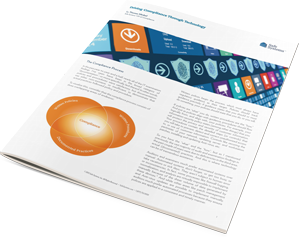How an Automated Solution Can Enhance Your Cybersecurity Posture

Our industry has seen the frequency and severity of cybersecurity attacks continue to increase, with recent attacks involving extortion, destructive malware and compromised credentials. In fact according to the FDIC, Information Security Incidents were up 48% in 2014, and we expect similar increases this year. In light of the increasing volume and sophistication of cyber threats, the Federal Financial Institutions Examination Council (FFIEC) developed the Cybersecurity Assessment Tool (CAT) in 2015. The assessment provides institutions with a repeatable and measureable process to inform management of their institution’s cybersecurity risks and preparedness.
What Do Examiners Expect You to Demonstrate?
While use of the CAT by financial institutions is voluntary, examiners expect all financial institutions to use some sort of framework or risk assessment process to demonstrate cybersecurity preparedness. This is important not only for the health of the institution, but also for the financial industry as a whole. Moreover, careful consideration of cybersecurity risk is absolutely critical when complying with regulatory requirements, as the new cyber elements will be added to future IT examinations. For many bankers, responding to an IT examination has become so time-consuming that it is essentially full time job. Having a user-friendly automated tool would certainly help streamline the assessment process, but to date, the FFIEC has not indicated that it intends to release an automated version of the CAT.
So, increasingly bankers are investigating their options when it comes to automating the assessment and reporting process. A well-designed automated solution should help financial institutions take a more informed, proactive approach to managing periodic FFIEC cybersecurity assessments. It should help bankers easily identify and resolve any cybersecurity gaps in an efficient manner, while also meeting examiner expectations. Such a solution enables the financial institution to collect, summarize, and report on its cybersecurity posture coherently (and consistently) and be better prepared for the actual IT exam.
Your cybersecurity compliance solution should enable your institution to:
- Simplify the initial assessment by providing plain-English clarification for confusing questions;
- Provide a way to actually track responses from one assessment to the next, which helps with reporting back to regulators in terms of consistency and in better articulating progress over time;
- Develop thorough reports for the Board and other stakeholders, as well as a clearly articulated action plan;
- Be more proactive vs. reactive in managing cybersecurity risks, by including items such as incident response testing and Board reporting;
- Reduce the possibility of misinterpretation of information or questions, which can impact the accuracy of the entire assessment; and
- Better understand or predict what to expect from regulators in the future.

Driving Compliance Through Technology
Learn how automation and documentation can improve your financial
institution’s compliance posture

An Automated Solution for Community Banks
At Safe Systems, we understand that managing cybersecurity has become very time consuming and stressful for financial institutions. To help streamline this process, we have developed Cybersecurity RADAR. This comprehensive compliance solution couples compliance expertise with access to our Enhanced Cybersecurity Assessment Tool (ECAT) application. We’ve transformed the FFIEC’s 123-page Cybersecurity Assessment Tool into a much more user-friendly digital interface. The web-based ECAT application is designed to capture and document periodic changes to an institution’s risk and maturity, empowering you to measure the state of your cybersecurity risks and controls within the FFIEC’s framework, and easily generate reports in preparation for Board meetings or exams.
In alignment with the ECAT, our compliance consultants will help you complete the assessment, identiy and resolve cybersecurity gaps, complete cyber Incident Response testing, and report to the Board, and train employees. This combination helps community banks and credit unions clearly demonstrate Cybersecurity preparedness and ensure a smoother IT exam process.

